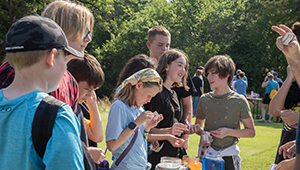Summer's here and schools are out, but the learning doesn't have to stop, especially when your golf course becomes an outdoor classroom. First Green field trips are an excellent way to provide interactive lessons for your local junior golf program, Scouts, Boys & Girls Clubs or other youth organizations. Getting started is easier than you think – GCSAA has the tools you need to host a successful First Green field trip.
First Green, established in 1997, is the only STEAM (science, technology, engineering, arts and math) program in the U.S. and Canada that transforms golf courses into living laboratories. GCSAA’s First Green immerses K–12 students in hands-on explorations of turf science, water conservation, soil health, wildlife habitats, math on the course and careers in golf course management. 
Why host a field trip this summer?
- Community connection: Introduce local youth groups — like Scouts or Boys & Girls Clubs — to the positive impact your golf course has on the environment and their community.
- Environmental stewardship: Showcase your efforts in water conservation, wildlife habitat preservation, native plantings and innovative turf science.
- Inspire future leaders: Ignite curiosity and show students the exciting role of a golf course superintendent, equipment manager or turfgrass scientist.
- Have fun: It’s summertime and that means fun! And while you know the kids will have fun – you and your team will, too. Golf course superintendents always say that hosting a field trip is a highlight of their year.
Easy steps to say “Yes” to First Green
1. Visit the First Green website: Learn more and register your interest in hosting a field trip.
2. Pick a youth partner: Reach out to your junior golf program or local groups like Scouts or the Boys & Girls Club. A personal intro always helps.
3. Outline your field trip: Work with First Green resources to choose activities and materials. Labs typically run 15–20 mins each — soil sampling, water testing, wildlife surveys, equipment demos and even putting challenges are all crowd favorites.
4. Finalize logistics: Set a date and plan for equipment, staff safety and any access needs.
5. Promote the event: Share it via local media, social posts or club newsletters to highlight your stewardship in action.
You don’t have to do it alone
GCSAA members have a full toolbox for success — from field trip planning guides to staff support during the event. Hosting a First Green field trip is a fun, meaningful way to engage youth, demonstrate environmental stewardship and strengthen community ties — all while showcasing the science and care behind your golf course. With support from GCSAA and easy-to-use resources, you can make a real difference this summer.
Get involved today — and inspire the next generation of environmental stewards, all from the greens you manage.
Interested in bringing students to your course this summer? Visit the www.thefirstgreen.org to learn more and start planning.
For personalized assistance, reach out to:
Leann Cooper,
director, First Green and workforce development.